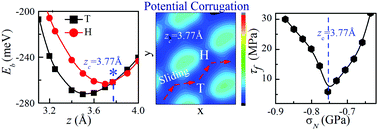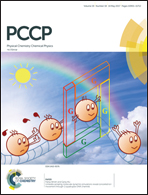Attraction induced frictionless sliding of rare gas monolayer on metallic surfaces: an efficient strategy for superlubricity†
Abstract
Friction on a nanoscale revealed rich load-dependent behavior, which departs strongly from the long-standing Amonton's law. Whilst electrostatic repulsion-induced friction collapse for rare gas sliding over metallic surfaces in a high-load regime was reported by Righi et al. (Phys. Rev. Lett., 2007, 99, 176101), the significant role of attraction on frictional properties has not been reported to date. In this study, the frictional motion of Xe/Cu(111), Xe/Pd(111) and Ar/Cu(111) was studied using van der Waals corrected density functional calculations. An attraction-induced zero friction, which is a signal of superlubricity, was found for the sliding systems. The superlubric state results from the disappearance of the potential corrugation along the favored sliding path as a consequence of the potential crossing in the attractive regime when the interfacial pressure approaches a critical-value. The finding of an attraction-driven friction drop, together with the repulsion-induced collapse in the high-load regime, which breaks down the classic Amonton's law, provides a distinct approach for the realization of inherent superlubricity in some adsorbate/substrate interfaces.

- This article is part of the themed collection: 2017 PCCP HOT Articles


 Please wait while we load your content...
Please wait while we load your content...